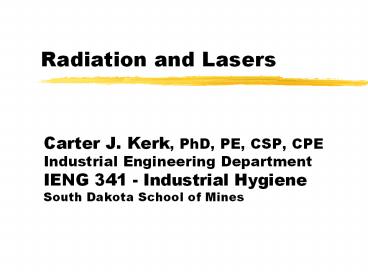Radiation and Lasers - PowerPoint PPT Presentation
Title:
Radiation and Lasers
Description:
Cell Phones. Electromagnetic Spectrum ... modern conveniences such as cellular phones, medical x-rays, pagers, TVs, and radios to operate. ... – PowerPoint PPT presentation
Number of Views:47
Avg rating:3.0/5.0
Title: Radiation and Lasers
1
Radiation and Lasers
- Carter J. Kerk, PhD, PE, CSP, CPE
- Industrial Engineering Department
- IENG 341 - Industrial Hygiene
- South Dakota School of Mines
2
Assignment
- Read Chapter 10 Ionizing and Non-Ionizing
Radiation - Critical Thinking Questions
- p. 241
- 1 4
- Due?
3
Introduction
- Radiation Control for Health Safety Act of 1960
- Several government standards
- OSHA
- CPSC
- FDA
- Consensus standards
4
Non-Ionizing Radiation
- There are many sources of radiant energy sun,
fire, microwaves, radio transmissions, atomic
reactors, lamps, lasers. - It takes 10 12 eV or more to break the bond of
molecular elements. Sources of radiant energy
below this level are considered non-ionizing. - Sources above this level are considered
ionizing. Ionizing radiation is any
electromagnetic or particulate radiation capable
of producing ions when it interacts with atoms or
molecules.
5
Types of Non-Ionizing Radiation
- Microwaves
- Ultraviolet Radiation
- Infrared Radiation
- High Intensity Visible Light
- Lasers
- VDTs
- Low Frequency Electric and Magnetic Fields
- lt 60 Hz ELF (Extremely Low Frequency), normally
near high voltage transmission lines - Cell Phones
6
Electromagnetic Spectrum
Electromagnetic Spectrum contains all the wave
energies that allow modern conveniences such as
cellular phones, medical x-rays, pagers, TVs, and
radios to operate.
7
Hazards of Non-Ionizing Radiation
- Although energy levels do not affect molecular
structure, non-ionizing radiation can affect
biological tissue by changing energy levels in
tissue molecules, often producing heat - Heat easily effects certain tissue
- Eye has little blood circulation and little
ability to remove heat through blood flow
8
Absorption properties of the eye for
electromagnetic radiation
9
Microwaves
- Uses Communication, navigation, medical
diathermy, microwave ovens, drying equipment - Frequencies 30 MHz 300 GHz
- Wavelengths 1 mm 10 m
- Waves lt 3 cm are absorbed in outer skin
- 3 10 cm penetrate from 1 mm 1 cm
- 25 200 cm penetrate to deeper tissues organs
- gt 200 cm, human tissue is transparent
- Absorbed radiation is primarily converted to
heat, possibly to hazardous levels - Greatest danger eyes cataracts, some
pacemakers
10
Microwave Controls
- Limit exposure and/or intensity
- Distance from source
- Shielding
11
MicrowaveMeasurement Standards
- Measure microwaves with thermal or electrical
detector instruments - OSHA 29 CFR 1910.97
- Limit power density to 10 mW/cm2 for exposures gt
0.1 hr - For lt 0.1 hr, limit energy density to 1 mW-hr /
cm2
12
Microwave Standards
- ACGIH publishes limits
13
Lasers
- LASER acronym for Light Amplification by
Stimulated Emission of Radiation - Intense, coherent, directional optical radiation
- Consists of an energy source, resonant cavity,
and an active laser medium - An assembly of electrical, mechanical, and
optical components - Becoming increasingly common welding,
machining, measuring, alignment, checkout
scanners, printers, medical applications, etc.
14
Laser Hazards
- Some lasers are very dangerous and others not at
all - Hazard depends on intensity, wavelength, duration
of exposure, and body part exposed - With high energy levels, heat builds causing
combustion
15
Laser Hazards
- Lasers can fall in visible, ultraviolet and
infrared ranges - Greatest danger is visible range
The optical spectrum. Laser light is nonionizing
and ranges from theultra-violet (100 - 400nm),
visible (400 - 700nm), and infrared (700nm -
1mm).
16
Laser Hazards
- The eye is most vulnerable
- The cornea (the clear, outer surface of the eye's
optics) does not have an external layer of dead
cells to protect it from the environment. - Light entering the eye from a collimated beam is
concentrated by a factor of 100,000 times when it
strikes the retina
17
(No Transcript)
18
(No Transcript)
19
(No Transcript)
20
(No Transcript)
21
Safety Standards
- American National Standards Institute's Z136
series of laser safety standards. - These standards are the foundation of laser
safety programs in industry, medicine, research,
and government. - The ANSI Z136 series of laser safety standards
are referenced by the Occupational Safety
and Health Administration (OSHA) - Provides information on how to classify lasers
for safety, laser safety calculations and
measurements, laser hazard control measures, and
recommendations for Laser Safety Officers
22
Controlling Laser Hazards
- Engineering Controls (most reliable)
- Protective housings and interlocks, protective
filter installations, key-controls, and system
interlocks - Administrative Controls
- Standard operating procedures
- Facilities using Class 3b or Class 4 lasers or
laser systems should designate a Laser Safety
Officer
23
Assignment
- Read Chapter 10 Ionizing and Non-Ionizing
Radiation - Critical Thinking Questions
- p. 241
- 1 4
- Due?

